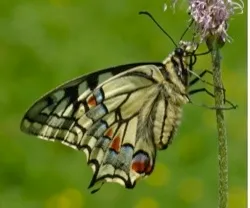
Butterfly Conservation has revealed that a rare type of butterfly, the Continental Swallowtail, may be colonising the UK. They are now calling for members of the public to log their sightings of the tropical-looking species.
Adult Continental Swallowtails, Papilio machaon gorganus, have been spotted hatching in Sussex over the past few weeks, meaning they have successfully bred and their caterpillars have survived the mild winter months.
Michael Blencowe from Butterfly Conservation’s Sussex Branch said: ‘This current invasion could be the start of the colonisation of Southern England by the Swallowtail. In 20 years this butterfly could be a regular visitor to our gardens.’
Last year’s hot summer, which charity Butterfly Conservation have called the largest continental Swallowtail invasion since 1945, led to the butterflies laying eggs along the south coast in Hastings, Eastbourne and Chichester. Sightings were also recorded in Suffolk, Kent, Hampshire and Dorset.
The eye-catching Continental Swallowtail is easy to spot. Butterfly Conservation have said that the Swallowtail cannot be mistaken for any other UK butterfly due to its size, striking yellow and black colouration and long tail streamers. Their location, centered around the South Coast, is another key identifier.
Matthew Oates, the National Trust’s national specialist on nature, explained that the Continental Swallowtail ‘breeds on a variety of plants, both in the countryside and in gardens. Some of these plants are fairly common. The potential for it colonising South England is therefore quite significant.
‘But, to become established here it will need a sequence of long hot summers’.
The UK has its own native subspecies of swallowtail, Papilio machaon britannicus, solely found on the Norfolk Broads in a rare yet stable population. The Continental Swallowtail is bigger, brighter and is more yellow than the British form.
Oates said that the colonisation of Continental Swallowtails would be unlikely to cause any ecological damage, and further explained that ‘the only issue is whether it will hybridise with our native sub-species. I think that's unlikely to happen but if it does it will be due to entirely natural processes, and it would be very hard to tell the different species and the hybrid(s) apart.’
The BBC's Springwatch filmed some of these strikingly colourful butterflies hatching in a normal UK garden.
The arrival of the Continental Swallowtails makes it an incredibly exciting time to be interested in butterflies. As Oates stated: ‘Butterflies push limits, seek new opportunities. They're seldom static for long.’
Have you seen a Continental Swallowtail in Britain? Butterfly Conservation want to hear about any Swallowtails seen in Southern England. Please send details of your sightings to Michael Blencowe at Butterfly Conservation sussexgrayling@aol.com
Image © Butterfly Conservation
